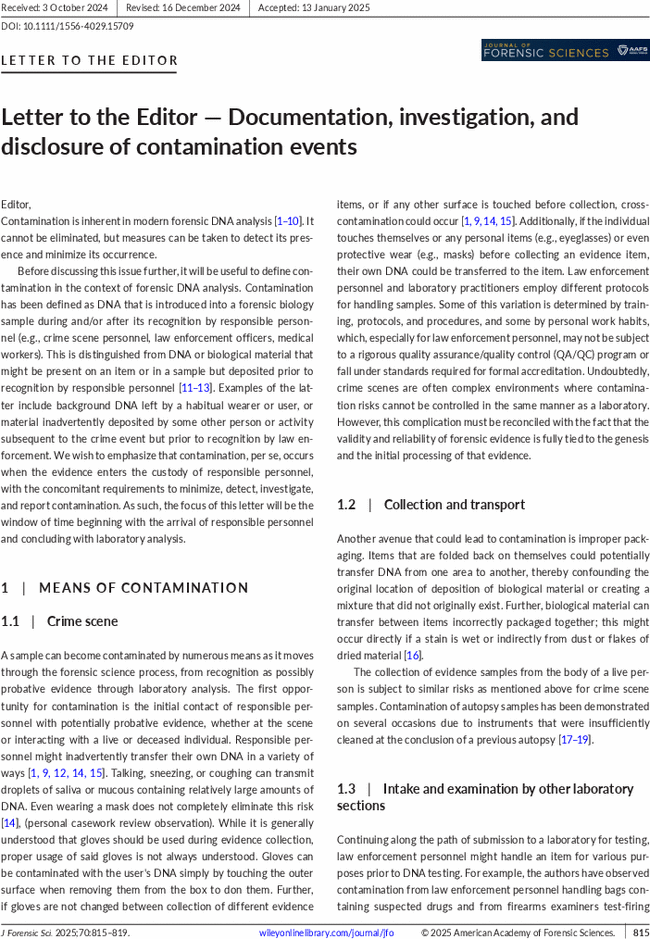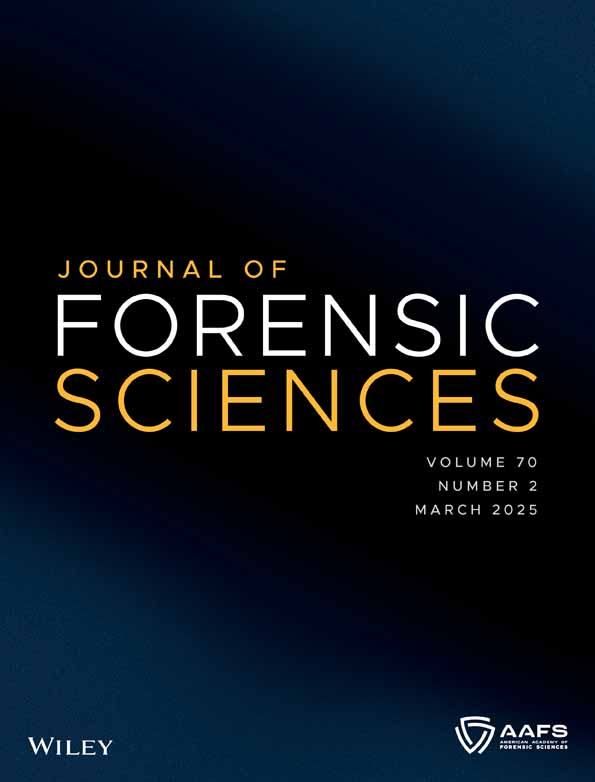Letter to the Editor — Documentation, investigation, and disclosure of contamination events
Corresponding Author
Norah Rudin PhD
Forensic DNA Consultant, Mountain View, California, USA
Correspondence
Norah Rudin, Forensic DNA Consultant, Mountain View, CA, USA.
Email: [email protected]
Search for more papers by this authorKeith Inman MCrim
Leverhulme Research Centre for Forensic Science, University of Dundee, Dundee, UK
Department of Criminal Justice, California State University East Bay, Hayward, California, USA
Search for more papers by this authorMaher (Max) Noureddine PhD, MS
ForensiGen, LLC, Oak Ridge, North Carolina, USA
Adjunct Faculty, Anthropological Sciences Program, Radford University, Radford, Virginia, USA
Search for more papers by this authorCorresponding Author
Norah Rudin PhD
Forensic DNA Consultant, Mountain View, California, USA
Correspondence
Norah Rudin, Forensic DNA Consultant, Mountain View, CA, USA.
Email: [email protected]
Search for more papers by this authorKeith Inman MCrim
Leverhulme Research Centre for Forensic Science, University of Dundee, Dundee, UK
Department of Criminal Justice, California State University East Bay, Hayward, California, USA
Search for more papers by this authorMaher (Max) Noureddine PhD, MS
ForensiGen, LLC, Oak Ridge, North Carolina, USA
Adjunct Faculty, Anthropological Sciences Program, Radford University, Radford, Virginia, USA
Search for more papers by this author
REFERENCES
- 1Taylor MK. Forensic DNA interpretation and human factors: improving the practice through a systems approach. Gaithersburg, MD: National Institute of Standards and Technology; p. NIST IR 8503; 2024. https://doi.org/10.6028/NIST.IR.8503
10.6028/NIST.IR.8503 Google Scholar
- 2Kwok S, Higuchi R. Avoiding false positives with PCR. Nature. 1989; 339: 237–238. https://doi.org/10.1038/339237a0
- 3Kitchin PA, Szotyori Z, Fromholc C, Almond N. Avoidance of false positives. Nature. 1990; 344: 201. https://doi.org/10.1038/344201a0
- 4Bar W, Brinkmann B, Lincoln P, Mayr W, Rossi U. DNA Commission of the International Society for Forensic Haemogenetics. Int J Leg Med. 1992; 105: 63–64. https://doi.org/10.1007/BF01371243
- 5Wilson MR, DiZinno JA, Polanskey D, Replogle J, Budowle B. Validation of mitochondrial DNA sequencing for forensic casework analysis. Int J Leg Med. 1995; 108: 68–74. https://doi.org/10.1007/BF01369907
- 6Toledano T, Quarino L, Leung S, Buffolino P, Baum H, Shaler RC. An assessment of DNA contamination risks in New York City Medical Examiner Facilities. J Forensic Sci. 1997; 42(4): 721–724. https://doi.org/10.1520/JFS14191J
- 7Urban C, Gruber F, Kundi M, Falkner FG, Dorner F, Hämmerle T. A systematic and quantitative analysis of PCR template contamination. J Forensic Sci. 2000; 45(6): 1307–1311. https://doi.org/10.1520/JFS14885J
- 8Kloosterman A, Sjerps M, Quak A. Error rates in forensic DNA analysis: definition, numbers, impact and communication. Forensic Sci Int Genet. 2014; 12: 77–85. https://doi.org/10.1016/j.fsigen.2014.04.014
- 9Fonneløp AE, Egeland T, Gill P. Secondary and subsequent DNA transfer during criminal investigation. Forensic Sci Int Genet. 2015; 17: 155–162. https://doi.org/10.1016/j.fsigen.2015.05.009
- 10Mercer C, Taylor D, Henry J, Linacre A. DNA accumulation and transfer within an operational forensic exhibit storeroom. Forensic Sci Int Genet. 2023; 62:102799. https://doi.org/10.1016/j.fsigen.2022.102799
- 11Inman K, Rudin N. Principles and practice of criminalistics: the profession of forensic science. Boca Raton, FL: CRC Press; 2000. https://doi.org/10.1201/9781420036930
10.1201/9781420036930 Google Scholar
- 12Van Oorschot RAH, Szkuta B, Meakin GE, Kokshoorn B, Goray M. DNA transfer in forensic science: a review. Forensic Sci Int Genet. 2019; 38: 140–166. https://doi.org/10.1016/j.fsigen.2018.10.014
- 13 Forensic Science Regulator. Guidance: contamination controls – scene of crime. FSR-GUI-0016. Birmingham: The Forensic Science Regulator; 2023.
- 14Rutty GN, Hopwood A, Tucker V. The effectiveness of protective clothing in the reduction of potential DNA contamination of the scene of crime. Int J Leg Med. 2003; 117: 170–174. https://doi.org/10.1007/s00414-002-0348-1
- 15Pickrahn I, Kreindl G, Müller E, Dunkelmann B, Zahrer W, Cemper-Kiesslich J, et al. Contamination incidents in the pre-analytical phase of forensic DNA analysis in Austria—statistics of 17 years. Forensic Sci Int Genet. 2017; 31: 12–18. https://doi.org/10.1016/j.fsigen.2017.07.012
- 16Goray M, Van Oorschot RAH, Mitchell JR. DNA transfer within forensic exhibit packaging: potential for DNA loss and relocation. Forensic Sci Int Genet. 2012; 6: 158–166. https://doi.org/10.1016/j.fsigen.2011.03.013
- 17Cemper-Kiesslich J, Tutsch-Bauer E, Neuhuber F. Another phantom from the morgue—a case of instrument-born sample contamination in the course of identifying an unknown deceased. Forensic Sci Int Genet. 2013; 7: 405–407. https://doi.org/10.1016/j.fsigen.2013.01.003
- 18Gunn DG. Re: Forensic exhibits—precautions to avoid contamination. J Clin Forensic Med. 1998; 5(4): 218. https://doi.org/10.1016/S1353-1131(98)90159-6
- 19Rutty GN, Watson S, Davison J. DNA contamination of mortuary instruments and work surfaces: a significant problem in forensic practice? Int J Leg Med. 2000; 114: 56–60. https://doi.org/10.1007/s004140000142
- 20Szkuta B, Oorschot RAHV, Ballantyne KN. DNA decontamination of fingerprint brushes. Forensic Sci Int. 2017; 277: 41–50. https://doi.org/10.1016/j.forsciint.2017.05.009
- 21Taylor D, Abarno D, Rowe E, Rask-Nielsen L. Observations of DNA transfer within an operational forensic biology laboratory. Forensic Sci Int Genet. 2016; 23: 33–49. https://doi.org/10.1016/j.fsigen.2016.02.011
- 22 SWGDAM. Contamination prevention and detection guidelines. 2017. Available from: https://www.swgdam.org/_files/ugd/4344b0_c4d4dbba84f1400a98eaa2e48f2bf291.pdf. Accessed 13 Jan 2025.
- 23 Applied BioSystems. Super Wash 3 module to minimize injection to injection carryover in HID laboratories. Waltham, MA: Applied Biosystems; 2013.
- 24 Applied Biosystems. Maximizing the performance of capillary electrophoresis systems. 2010. Forensic News. Available from: https://tools.thermofisher.com/content/sfs/brochures/cms_086053.pdf. Accessed 13 Jan 2025.
- 25 Applied Biosystems. Considerations for evaluating carryover on Applied Biosystems capillary electrophoresis platforms in a HID laboratory. Waltham, MA: Applied Biosystems; 2012.
- 26Gill P, Kirkham A. Development of a simulation model to assess the impact of contamination in casework using STRs. J Forensic Sci. 2004; 49(3): 485–491. https://doi.org/10.1520/JFS2003366
- 27 Academy Standards Board. ANSI/ASB Standard 175 – Standard for interpreting, comparing and reporting DNA test results associated with failed controls and contamination events. Colorado Springs, CO: Academy Standards Board; 2024. Available from: https://www.aafs.org/sites/default/files/media/documents/175_Std_e1.pdf. Accessed 13 Jan 2025.
- 28 Texas Forensic Science Commission. Final report on complaint by Lisa Gefrides against the Houston Forensic Science Center. Austin, TX: Texas Forensic Science Commission; 2018, p. 276. Report No.: 17-04.
- 29 Academy Standards Board. ANSI/ASB Best Practice Recommendation 171 – Best practice recommendations for the management and use of quality assurance DNA elimination databases in forensic DNA analysis. 2024. Available from: https://www.aafs.org/sites/default/files/media/documents/171_BPR_e1.pdf. Accessed 13 Jan 2025.
- 30Lapointe M, Rogic A, Bourgoin S, Jolicoeur C, Séguin D. Leading-edge forensic DNA analyses and the necessity of including crime scene investigators, police officers and technicians in a DNA elimination database. Forensic Sci Int Genet. 2015; 19: 50–55. https://doi.org/10.1016/j.fsigen.2015.06.002
- 31Taylor D, Rowe E, Kruijver M, Abarno D, Bright J-A, Buckleton J. Inter-sample contamination detection using mixture deconvolution comparison. Forensic Sci Int Genet. 2019; 40: 160–167. https://doi.org/10.1016/j.fsigen.2019.02.021
- 32 Houston Forensic Science Center. Welcome to Houston Forensics Science Center record search. Available from: https://records.hfscdiscovery.org. Accessed 13 Jan 2025.
- 33 Texas Forensic Science Commission. Texas Forensic Science Commission investigative reports. 2024. Available from: https://www.txcourts.gov/fsc/publications-reports/investigative-reports/. Accessed 13 Jan 2025.
- 34Gefrides LA, Powell MC, Donley MA, Kahn R. UV irradiation and autoclave treatment for elimination of contaminating DNA from laboratory consumables. Forensic Sci Int Genet. 2010; 4: 89–94. https://doi.org/10.1016/j.fsigen.2009.06.008
- 35Neureuther K, Rohmann E, Hilken M, Sonntag M-L, Herdt S, Koennecke T, et al. Reduction of PCR-amplifiable DNA by ethylene oxide treatment of forensic consumables. Forensic Sci Int Genet. 2014; 12: 185–191. https://doi.org/10.1016/j.fsigen.2014.06.006
- 36Hymus CM, Cooper PL, Rye MS. Demonstration of potential DNA contamination introduced by laboratory consumables using Fluorescein. Forensic Sci Int Genet. 2025; 74:103157. https://doi.org/10.1016/j.fsigen.2024.103157
- 37Rechsteiner M. AB ladder contamination. Waltham, MA: Applied BioSystems; 2005.




